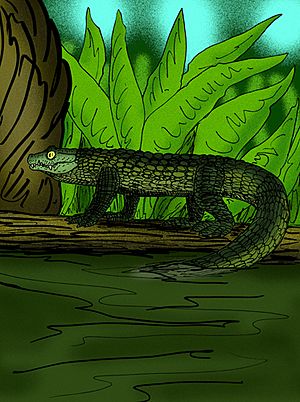Mekosuchus facts for kids
Quick facts for kids Mekosuchus |
|
|---|---|
 |
|
| Mekosuchus inexpectatus mandible | |
| Scientific classification |
|
| Kingdom: | Animalia |
| Phylum: | Chordata |
| Class: | Reptilia |
| Order: | Crocodilia |
| Family: | Crocodylidae |
| Subfamily: | †Mekosuchinae |
| Tribe: | †Mekosuchini |
| Genus: | †Mekosuchus Balouet & Buffetaut, 1987 |
| Type species | |
| †Mekosuchus inexpectatus Balouet & Buffetaut, 1987
|
|
| Species | |
|
|
Mekosuchus was a type of crocodile that lived in the South Pacific region, including Australia. These crocodiles are now extinct, meaning they no longer exist. Scientists believe that humans arriving on the islands where Mekosuchus lived might have caused their disappearance.
Unlike most crocodiles today, Mekosuchus was quite small, growing up to about 2 meters (6.5 feet) long. They were also mostly land-dwelling, which is unusual for crocodiles. This makes them the last known group of crocodiles that lived almost entirely on land. Today, most crocodiles live in water, though some, like the Cuban crocodile, spend time on land.
Fossils of ancient relatives of Mekosuchus, like Trilophosuchus, have been found in Australia. The oldest known relative, Kambara, lived even earlier. Another related crocodile, Quinkana, also survived until humans arrived. Mekosuchus itself lived until relatively recently, with their bones found in New Caledonia and Vanuatu.
Contents
Different Kinds of Mekosuchus
Scientists have identified four different species of Mekosuchus. Each species lived in a different time or place.
M. inexpectatus: The Unexpected Crocodile
The first Mekosuchus species discovered was M. inexpectatus. It lived on the island of New Caledonia and became extinct about 4,000 years ago. This was around the time humans first arrived there.
Because the soil in New Caledonia was not very rich, there weren't many large animals for M. inexpectatus to hunt. So, this crocodile developed special back teeth. These teeth were perfect for cracking open the shells of molluscs (like snails) and arthropods (like crabs). However, it probably also ate lizards and birds when it could.
M. kalpokasi: From Vanuatu
Another species, M. kalpokasi, lived on the island of Éfaté in Vanuatu. It disappeared about 3,000 years ago, also around the time humans arrived on that island.
Older Australian Species
The oldest known species is M. whitehunterensis. It lived in Queensland, Australia, during the late Oligocene period. Another species, M. sanderi, also lived in Queensland but later, during the Miocene period.
See also
 In Spanish: Mekosuchus para niños
In Spanish: Mekosuchus para niños


